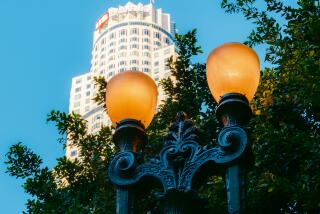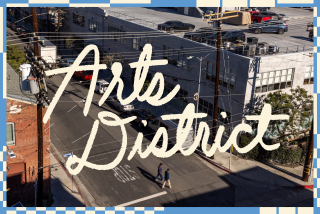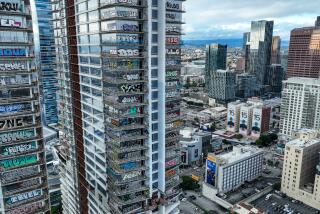Whimsical project puts Athensâ Pittaki Street in a better light
ATHENS â Locals called Pittaki Street a âpublic toilet.â
Drug addicts and petty criminals frequented the narrow lane, steps from a popular plaza where tourists exploring Greece angle for shots of the looming Acropolis. The scraggle of remaining residents kept to themselves. Graffiti and broken windows adorned grimy walls.
Two dimly illuminating streetlights dangled overhead.
âIt was a very nasty place where you didnât want to live,â Stephania Xydia said as she stood looking down the avenueâs 200 feet, dusk spilling over the rooftops. âIt was very dark.â
But look up now, and every night Pittaki Street glitters with light.
Strings of lamps stretch from building to building. Some of the 150 bulbs are housed in standard funnel shades, others in waterproofed paper globes. A few coverings are unconventional: iron chandeliers, garden watering cans, something that looks like a colander.
Instead of warily scurrying past, many people wander steadily into the glow, hamming for photos with their friends. The junkies have largely cleared out. A few foreigners rent rooms on the strip. A small carnival was recently hosted beneath the lights, with costumed revelers in wigs, masks and hats crowding together.
As far as outdoor art statements go, this one is relatively modest; itâs no undulating Chihuly glass garden or snaking Central Park gates. It cost about $40,500 to install late last year, with Athenians donating unwanted fixtures from their homes and Coca-Cola sponsoring the production expenses.
Some residents say the lights are a beacon of hope for Athens, a signal that Greeceâs capital can emerge from the debilitating financial muck in which itâs been mired for years. Itâs one of a growing number of efforts headlined by citizens impatient with the governmentâs slow attempts at redevelopment.
Xydia, 26, serves as project manager for the Pittaki lights. She and several other young Athenians make up Imagine the City, an offshoot of nonprofit group PlaceIdentity.gr, which coordinated the installation.
The organization launched in 2009 and recruits Greeks to dream up urban regeneration proposals. Pittaki is the first physical manifestation of their ideas.
The group partnered with an artistsâ collective called Beforelight, which had installed a one-night version of the lights in the northern city of Thessaloniki. After much wrangling, the city of Athens granted a permit that pumped electricity to the Pittaki Street system.
Pittaki Street was once crowded with craftsmen making leather and buttons in their workshops. But their numbers dwindled over the decades, and collapsed almost completely amid gentrification efforts and the run-up to the Summer Olympics in Athens in 2004.
Developers preparing for the expected influx of visitors to the Games swarmed into Pittaki and its Monastiraki neighborhood, throwing up bars, clubs and restaurants. The noise cleared out most of the remaining residents. And then the debt crisis killed off the night life, leaving an aboveground catacomb of dead urban buildings a short walk from the luxurious real estate ringing the base of the Acropolis.
Athenians have struggled under the stringent austerity efforts implemented as a condition of Greeceâs multibillion-euro bailouts by its European neighbors. Cycles of wage cuts, layoffs and tax increases have exacerbated the pain of six straight years of recession and helped stoke political extremism.
âThis is very small scale; itâs not a revolution,â Xydia said. âBut since the crisis, more Greeks want to be involved in the revival of urban spaces.â
Commerce has tentatively taken root on Pittaki Street. Thereâs a spray-paint shop and an operation that offers HIV tests.
George Samoilis, 36, recently opened a T-shirt boutique on the street, moving from a more comfortable perch in Athensâ downtown Exarchia district.
âIt was a mess. You wouldnât crossâ a larger thoroughfare to reach Pittaki Street âafter late afternoon,â said Samoilis, sitting at twilight amid his cutting boards, sewing machines and thread spools. âNow, a lot of people are crossing for the lights.â
But the sense of camaraderie and liveliness cultivated by the newly luminous street is tenuous.
Banksy-esque drawings were commissioned for the project, featuring beds and other cozy household scenes, representing the union of private and public spaces. The etchings have since been scrawled over by graffiti artists.
The city of Athens is waffling on renewing the permit for the lights, which took six months to clear in the first place. Local elections planned for May could usher in a new political slate unsympathetic to fantastical public art exhibitions.
Imagine the City has no official funding to keep the project going.
âThe lights might have to go out, but weâd figure something else out,â Xydia said. âI donât think the areaâs bad reputation will come back.â
More to Read
Sign up for Essential California
The most important California stories and recommendations in your inbox every morning.
You may occasionally receive promotional content from the Los Angeles Times.











